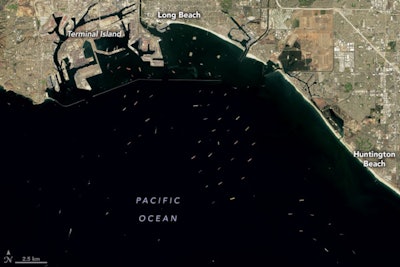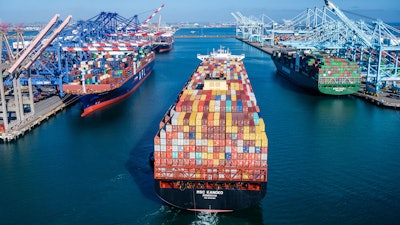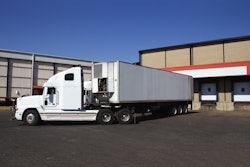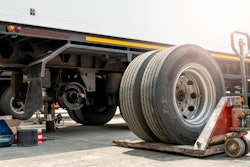
Supply chain players on various fronts told CCJ that they have little confidence in President Joe Biden’s initiative to alleviate congestion at the nation’s busiest ports.
The White House announced Wednesday that the president’s Supply Chain Disruptions Task Force had paved the way for 24/7 operations at the Ports of Los Angeles and Long Beach. The White House reports that both ports “are the point of entry for 40% of containers to the U.S., and are on track to reach new highs in container traffic this year.”
Major companies that rely heavily on those ports – like FedEx, UPS, Walmart, Home Depot and Target – have pledged to step up afterhours operations, which comes as welcome news following a failed 24-hour pilot program at the Port of Long Beach last month.
 A satellite photo provided by NASA earlier this month shows dozens of ships at anchor near the Ports of Los Angeles and Long Beach.NASA
A satellite photo provided by NASA earlier this month shows dozens of ships at anchor near the Ports of Los Angeles and Long Beach.NASA
Nonetheless, analysts and those working on the front lines during unprecedented freight imports say the president’s plan fails to fully address critical challenges like warehousing, equipment and driver shortages that have continued to create frustrating inefficiencies.
“Port throughput is not just taking containers off steamships, but having the capacity in the yard to position those containers, the chassis to put the containers on, the drivers to take the freight from the ports, and capacity in the rail network to facilitate the hoped for acceleration in port throughput,” said Kenny Vieth, president and senior analyst at ACT Research. “While the President’s recognition of the situation is welcome, and will undoubtedly help at the margin, this effort resembles squeezing a balloon: The problem appears likely to be pushed to the next mode with insufficient capacity."
“Fixing the problem at the port moves it to the next step in the supply chain. Trucking is already operating at capacity so adding more throughput requires them to operate more hours and more efficiently than they currently are able or willing to do." Rick Mihelic, director of emerging technologies, NACFE
The outlook on shifting to 24/7 ports isn’t much better for customs house broker Peter Wittwer North America in Largo, Florida.
“Nothing will change if ports operate 24 hours,” said Siegfried Adam, Jr. “There are not enough truckers to work three shifts per day nor does the hinterland infrastructure support hundreds of more containers to be unloaded in a 24-hour period. It’s a dumb idea. It solves nothing."
Rick Mihelic, director of emerging technologies at the North American Council for Freight Efficiency, said shifting to a 24/7 model adds additional strain to industry channels that are already struggling to keep up.
“Twenty-four hour operations at the ports impact all the downstream resources as well, warehouses, trucks, trains, distribution centers, retail outlets and factories,” Mihelic said. “Fixing the problem at the port moves it to the next step in the supply chain. Trucking is already operating at capacity so adding more throughput requires them to operate more hours and more efficiently than they currently are able or willing to do."
Critical links in the chain
With a broad trucking and port history that spans back to 1950, Dependable Supply Chain Services is concerned about the road ahead.Leonard Arriola, director of intermodal and drayage services at Dependable, a full-service logistics provider that serves all the major ports in California, said opening up the ports around the clock is not enough to alleviate record congestion.
Arriola pointed out major inefficiencies in container return procedures along with equipment and labor shortages, which have continued to hamper port operations.
“Extending the hours alone will not alleviate the problem,” Arriola said from his office in Los Angeles. "The major roadblock is the inability to return empty containers in a timely manner. I currently have 890 containers out on my own private fleet of chassis and 375 of them have empty containers on them that do not have a return location because one, there’s nowhere to return them; two, return restrictions; and three no [return] appointments are available.”
 Around the clock port operations can invite plenty of challenges according to Rick Mihelic, director of emerging technologies at the North American Council for Freight Efficiency. "The equipment to move cargo may not be positioned where it is needed. As warehouses have filled up, a lot of inventory may be in 'temporary warehousing' meaning sitting in trailers, railcars and containers, so they are not free to cycle where they need to be. Finding places to move inventory may mean locating it in other regions as warehouses reach capacity. This means longer trip distances should be expected."Port of Los Angeles
Around the clock port operations can invite plenty of challenges according to Rick Mihelic, director of emerging technologies at the North American Council for Freight Efficiency. "The equipment to move cargo may not be positioned where it is needed. As warehouses have filled up, a lot of inventory may be in 'temporary warehousing' meaning sitting in trailers, railcars and containers, so they are not free to cycle where they need to be. Finding places to move inventory may mean locating it in other regions as warehouses reach capacity. This means longer trip distances should be expected."Port of Los Angeles
“Returning empty containers has been a challenge with terminals restricting the return of empties because shiplines are over allocation,” Aboudi said.
Chassis availability is another issue that carriers have continued to battle long before the Biden administration formed the Supply Chain Disruptions Task Force in June to take on unprecedented port congestion, which on Friday had left 88 ships waiting at anchor near the ports of Los Angeles and Long Beach, according to the Marine Exchange of Southern California.
"During a regular ‘peak’ season we always run short of chassis," Arriola said, "now we have quadrupled the number of vessels arriving it has exasperated the shortage of chassis.”
Labor shortages have continued to hamper operations, too.
“There is also not enough labor to fully man the ports 24/7,” Arriola added. “If there are 9,000 dock workers over two shifts and you add a third shift, that brings you down from 4,500 workers per shift to 3,000 per shift. How is that going to increase productivity?
“There is an immediate need for more dock workers if even on a temporary basis, however the union may be a hurdle in this as they have a history of nepotism. As for the drivers, they will work around the clock if allowed,” Arriola continued.
Aboudi expressed disappointment at not hearing the president address hours of service and additional factors impacting productivity and the bottom line.
“Listening to the press conference, Biden spoke to Longshoremen, FedEx, Target, Home Depot...but I didn't hear mention of MTO [marine terminal operators] and truckers,” Aboudi said. “In an intermodal chain, all the parties have to work together.”
To further relieve the strain on carriers and owner-operators, Aboudi suggested that ports nix charging for street-turning containers and suspend per diem and demurrage charges “until the system is fluid.”
The bottom line
Being open 24 hours doesn’t guarantee additional container deliveries as Total Terminals International (TTI) learned last month at the Port of Long Beach.TTI, one of the largest terminals at the port, kicked off a 24-hour pilot program in mid-September and two weeks later still had not had any container pickups between 3 and 7 a.m. according to the The Wall Street Journal.
The Biden administration hopes that will change and that carriers and owner-operators will follow the examples of some of the largest fleets in the nation, like FedEx, UPS and Walmart, which have pledged to step up their afterhours operations to ease port congestion.
!['Prioritizing production of trucks and chassis will not do enough in the short term to make a difference [in alleviating port congestion],' said Leonard Arriola, director of intermodal and drayage services at Dependable Supply Chain Services. 'What would help is extending the hours of service for port drivers allowing them to work more hours in a day, and perhaps bringing the National Guard to help with the dock work.'](https://img.ccjdigital.com/files/base/randallreilly/all/image/2021/10/DHE_Truck_II.616cb372b6b40.png?auto=format%2Ccompress&fit=max&q=70&w=400) "Prioritizing production of trucks and chassis will not do enough in the short term to make a difference [in alleviating port congestion]," said Leonard Arriola, director of intermodal and drayage services at Dependable Supply Chain Services. "What would help is extending the hours of service for port drivers allowing them to work more hours in a day, and perhaps bringing the National Guard to help with the dock work."Dependable Supply Chain Services
"Prioritizing production of trucks and chassis will not do enough in the short term to make a difference [in alleviating port congestion]," said Leonard Arriola, director of intermodal and drayage services at Dependable Supply Chain Services. "What would help is extending the hours of service for port drivers allowing them to work more hours in a day, and perhaps bringing the National Guard to help with the dock work."Dependable Supply Chain Services
“I cannot believe it has taken this long to make this decision,” the trucking equipment CEO told CCJ under condition of anonymity. “If it adds precious hours of unloading time, it has to reduce the backlog over time.”
Port congestion has resulted in “much longer delays in getting goods into the country,” the CEO continued, and has made it “very difficult to pin down delivery times. Each month, we kick the can down the road a bit as sales are delayed by delivery delays.”
Big upticks in container costs are also impacting the bottom line.
“We are seeing $20,000 to $23,000 on 40-foot containers,” the CEO said. “We were paying about $5,500 last year at this time. Worse than the costs have been the delays in getting space on ships or getting goods delivered to the most obvious, close ports.”
High container costs can have big ripple effects beyond the ports.
“I think the global economy is suffering and action should be taken by governments to ease inflationary pricing,” the CEO said.
In addition to expanding hours at the Ports of Los Angeles and Long Beach, Mihelic suggested that more effective freight data management combined with additional government intervention could help take on piles of freight.
“Getting drivers and equipment where it is needed is something the market needs to solve in the near term,” Mihelic said. “Getting more licensed drivers and building more equipment is not a quick fix.
“We need to capitalize on the vast amount of digital freight data to quickly find where assets are sitting too long or being used as temporary storage or idle and then apply funding mechanisms to help expedite moving them to where they can help the network,” Mihelic continued. “The government’s best tool in an emergency often relates to dollars, either helping incentives or punitive measures.”













